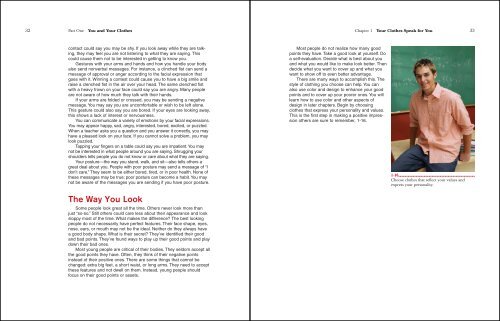CHAPTER 1 - Goodheart-Willcox
CHAPTER 1 - Goodheart-Willcox
CHAPTER 1 - Goodheart-Willcox
You also want an ePaper? Increase the reach of your titles
YUMPU automatically turns print PDFs into web optimized ePapers that Google loves.
32 Part One You and Your Clothes<br />
contact could say you may be shy. If you look away while they are talking,<br />
they may feel you are not listening to what they are saying. This<br />
could cause them not to be interested in getting to know you.<br />
Gestures with your arms and hands and how you handle your body<br />
also send nonverbal messages. For instance, a clinched fist can send a<br />
message of approval or anger according to the facial expression that<br />
goes with it. Winning a contest could cause you to have a big smile and<br />
raise a clenched fist in the air over your head. The same clenched fist<br />
with a heavy frown on your face could say you are angry. Many people<br />
are not aware of how much they talk with their hands.<br />
If your arms are folded or crossed, you may be sending a negative<br />
message. You may say you are uncomfortable or wish to be left alone.<br />
This gesture could also say you are bored. If your eyes are looking away,<br />
this shows a lack of interest or nervousness.<br />
You can communicate a variety of emotions by your facial expressions.<br />
You may appear happy, sad, angry, interested, bored, excited, or puzzled.<br />
When a teacher asks you a question and you answer it correctly, you may<br />
have a pleased look on your face. If you cannot solve a problem, you may<br />
look puzzled.<br />
Tapping your fingers on a table could say you are impatient. You may<br />
not be interested in what people around you are saying. Shrugging your<br />
shoulders tells people you do not know or care about what they are saying.<br />
Your posture—the way you stand, walk, and sit—also tells others a<br />
great deal about you. People with poor posture may send a message of “I<br />
don’t care.” They seem to be either bored, tired, or in poor health. None of<br />
these messages may be true; poor posture can become a habit. You may<br />
not be aware of the messages you are sending if you have poor posture.<br />
The Way You Look<br />
Some people look great all the time. Others never look more than<br />
just “so-so.” Still others could care less about their appearance and look<br />
sloppy most of the time. What makes the difference? The best looking<br />
people do not necessarily have perfect features. Their face shape, eyes,<br />
nose, ears, or mouth may not be the ideal. Neither do they always have<br />
a good body shape. What is their secret? They’ve identified their good<br />
and bad points. They’ve found ways to play up their good points and play<br />
down their bad ones.<br />
Most young people are critical of their bodies. They seldom accept all<br />
the good points they have. Often, they think of their negative points<br />
instead of their positive ones. There are some things that cannot be<br />
changed: extra big feet, a short waist, or long arms. They need to accept<br />
these features and not dwell on them. Instead, young people should<br />
focus on their good points or assets.<br />
Most people do not realize how many good<br />
points they have. Take a good look at yourself. Do<br />
a self-evaluation. Decide what is best about you<br />
and what you would like to make look better. Then<br />
decide what you want to cover up and what you<br />
want to show off to even better advantage.<br />
There are many ways to accomplish this. The<br />
style of clothing you choose can help. You can<br />
also use color and design to enhance your good<br />
points and to cover up your poorer ones. You will<br />
learn how to use color and other aspects of<br />
design in later chapters. Begin by choosing<br />
clothes that express your personality and values.<br />
This is the first step in making a positive impression<br />
others are sure to remember, 1-16.<br />
Chapter 1 Your Clothes Speak for You 33<br />
1-16<br />
Choose clothes that reflect your values and<br />
express your personality.
















